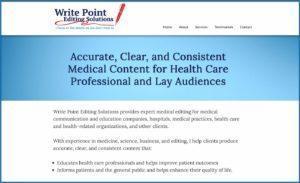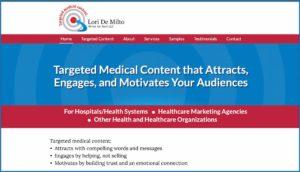A Behind-the-Scenes Look at 3 Professional and Awesome Websites
 A professional and awesome website helps freelancers get steady, high-paying clients. Here’s how three freelancers developed websites that are helping us thrive.
A professional and awesome website helps freelancers get steady, high-paying clients. Here’s how three freelancers developed websites that are helping us thrive.
If you’re like many freelancers, developing a professional and awesome freelance website seems like an agonizing task. But it doesn’t have to be. You only need two things for a professional and awesome website:
- Content that’s compelling, clear, and focused on client needs
- Design that’s visually engaging, clear, and easy to navigate.
Here’s how three freelancers—Kathleen Labonge, Margaret Johnson, and me—developed websites that are helping us get steady, high-paying clients.
Be More Successful
Not having a website was holding Kathleen back from being more successful in her freelance business. “I kept hearing from other successful freelancers that a website in this day and age was crucial,” says the medical copyeditor.
But Kathleen didn’t know how to begin developing a website. And as an editor, she wasn’t comfortable writing about herself and her business, Write Point Editing Solutions.
By the time Kathleen had been freelancing for about two years, she knew that she had to have a website. With the help of an online marketing course for freelancers and a professional website designer, it wasn’t as hard as she had thought it would be.
“People tell me that they like what they see on my website and it’s easy for them to get the information they need,” says Kathleen. “My website makes me feel more professional, and I think it helps potential clients take me seriously.”
Kathleen’s website not only makes her feel more professional; it also makes her look more professional. And that’s important, because clients expect freelancers to have professional and awesome websites.
Don’t Do It Yourself
Margaret tried to develop a website on her own but she knew that it wasn’t good enough to help her get steady, high-paying clients. “I’m not trained in web design and I made common mistakes,” says Margaret. “I need to spend my time on writing, not trying to figure out things like web design.”
Near the end of her first year as a freelance medical writer and editor, Margaret learned about developing a professional and awesome website in my online marketing course for freelancers. Like Kathleen, she wrote her web content as part of the course and hired a professional website designer to develop her awesome website.
But you don’t need to take a course to develop your freelance website. You can use The Ultimate Guide to an Awesome Freelance Website and these posts on freelance websites as your guide. Also check out my free templates. w
Keep Your Website Fresh
If you already have a website for your freelance business, then it might be time for an update.
In 2018, I updated my website for the third time. I developed my first website in 2002, and updated it in 2008, 2014, and 2018. Like most freelancers, the type of work I’d been doing, and most wanted to do, had evolved over time. Also, website design changes. I wanted a more modern design for my professional and awesome website.
Like Kathleen and Margaret, I wrote my content and hired a professional website designer to develop my website.
Work with a Professional Website Designer
We all hired professional website designers because we knew that our freelance websites needed to be professional and visually engaging. We also knew that trying to design our own websites would be frustrating and a waste of our time.
When you work with a professional website designer, you get a customized, visually engaging website that clearly communicates why clients should choose you to meet their freelance needs. You save time because you’re not trying to do something that you’re not qualified to do.
And we all had our designers create professional logos, which help us stand out from most freelancers. A logo is a visual way to represent your business that helps clients remember you.
As a fairly new freelancer, Kathleen didn’t have a whole lot of money in her business account. But she still found the expense of hiring a website designer well worth it. “Having a designer took a lot of the pressure off. I needed to focus on marketing my business, not figuring out how to do my website,” says Kathleen.
The Easiest Way to Develop a Professional and Awesome Freelance Website
Kathleen and I found our website designers through referrals from colleagues—the best way to find any type of help you need for your freelance business.
“A good designer will shepherd you through the website design and development process so that you’ll have an effective website for your freelance business that you love,” says Brian Corchiolo, my professional website designer. Brian owns bpc Creative and designs and develops amazing websites that are easy to navigate and exciting to use.
Brian developed my website, including the latest update in 2018, and Kathleen’s website. And he designed both of our logos.
Margaret found the designer for her website and logo, Seriously Creative, through a web search. “Seriously Creative stood out because their process was detailed and professional, and the price was appropriate,” she says.
Kathleen’s First Professional and Awesome Website
When I developed my first website in 2002, I hired a website designer but had to figure out the content on my own. There wasn’t much information available about websites for small businesses back then, and I couldn’t find anything about freelance websites.
Today, there’s a lot of information about website content. But other small businesses are different than freelance businesses. So some of what works for most small businesses isn’t necessary for freelancers—and can sometimes damage our businesses. Many designers don’t understand this and few gurus offer advice specifically on websites for freelancers.
Getting Freelancer-Focused Help
Kathleen found the freelancer-focused help she needed to develop her amazing website while taking my course, Finding the Freelance Clients You Deserve. She developed her freelance brand and her website at the same time. Both have client-focused marketing messages, which came out of Kathleen’s brand statement. A brand statement defines:
- What you offer: Services
- Who you offer it to: Target markets (types of clients you work with or want to work with)
- How you’re different or better than other freelancers (which is really how you position yourself in your marketing as being different or better).
Here’s Kathleen’s brand statement is:
“Medical communication and education companies, hospitals, medical practices, health care and health-related organizations, and other clients can count on me for accurate, clear, and consistent medical editing.”
From this brand statement, Kathleen created her home page headline:
“Accurate, Clear, and Consistent Medical Content for Health Care Professional and Lay Audiences.”
Here is part of Kathleen’s home page.

Visit her website to see what the rest of her home page and website look like.
Accurate, Clear, and Consistent Medical Content is how Kathleen positions herself as better or different than other freelancers. In the first paragraph of her home page, she says more about her services and defines her target markets:
“Write Point Editing Solutions provides expert medical editing for medical communication and education companies, hospitals, medical practices, health care and health-related organizations, and other clients.”
Kathleen also used her brand statement to develop her logo and tagline, which are the main ways to show your brand.
Learn More About Freelance Brands
Stand Out in a Sea of Freelancers: Your Brand
How Kathleen Labonge Boosts Awareness with her Freelance Brand
Working with a Professional Website Designer
Based on my recommendation, Kathleen hired Brian to develop her logo and her website. Kathleen and Brian chatted about what she was looking for. “I told him I wanted something simple and professional, nothing flashy,” she says. Brian gave Kathleen several options for the design of her website. I gave Kathleen feedback on the designs and she then worked with Brian to refine the design.
Generally, website templates use a lot of images. But images that don’t contribute to key messages are harmful on a freelancer’s website. So Kathleen only used her logo, the best type of image for a freelancer’s website, and her photo. Kathleen’s logo is on the top left corner of every page—the first place people look on any website.
“A logo helps you connect with your potential client,” says Brian. “It tells the potential client something about you and what you do before they get into the website and start reading.”
Kathleen also got feedback as her design evolved. Along with my coaching, she asked family members of different ages what they thought about her website.
“If I hadn’t had an expert like Lori helping guide me to figure out what content was necessary and what wasn’t, it would have been a whole lot harder,” she says.
Margaret’s Website Shift from Do-It-Yourself to Professional and Amazing
Like Kathleen, Margaret developed her freelance brand and her professional and amazing website at the same time. After defining her specialty, Margaret wrote her client-focused marketing messages. Defining your specialty is important, because you can’t do client-focused marketing unless you know the types of clients (target markets) you want to work with and what they need.
Margaret defined her specialty as medical and scientific writing and editing, and her target markets as medical communications agencies, medical education agencies, research organizations, and other clients. From this she wrote key marketing messages to address the needs of these clients, like her home page headline:
Accurate and timely services to support innovation in drugs and medical devices
Here is part of Margaret’s home page.

Visit her website to see what the rest of her home page and website look like.
Working with a Professional Website Designer
Margaret met with her designers at Seriously Creative by Zoom. They talked about the key message and ideas and colors for her logo, and for her website, the page organization she liked. “I wanted my logo to be simple, clear and easily recognizable, and show what’s unique about me and my business,” she says. Margaret chose a bold and innovative tone of voice.
After developing Margaret’s logo, the designers moved on to her website. Along with her logo, Margaret’s website home page has images that are relevant to a freelance writer and editor.
For both projects, the designers provided concepts for review. Based on Margaret’s feedback, the designers refined the concepts until Margaret had a professional logo and website that showed what was unique about her business.
“It’s important to give the designer as much information as possible, such as design elements you like and examples of other websites that are effective in your field,” says Margaret. “As well, I recommend finding a company you trust and are comfortable with.”
My Website Update
My 2018 update was primarily to develop a more modern design. But the new design also allowed me to highlight my key messages more on my home page and every page. Each page now has a banner near the top with a headline and key message. And I updated some of the language I used to describe my work for the digital era.
Working with a Professional Website Designer
I did some research before updating my website, and sent Brian examples of websites I liked (URLs and screen shots) and what I liked about them. “Explaining design and graphics is hard,” says Brian. “That’s why I ask clients to send me anything they like.” My current website is modeled on the website of one of my clients. But Brian customized it for me, since my website is much simpler than hers.
Brian also came up with a way to make my Home page unique that I never would have thought of on my own. He created a banner image based on my logo. Using the concept of the bulls-eye in my logo, he created a simple yet powerful background image of the circles in the bulls-eye and put my headline over this. You can see my logo (which Brian also designed) and my banner image on my Home page.
Here is part of my home page.

Visit my website to see what the rest of my home page and website look like.
Also, I updated my Samples page to make each sample more visually engaging. Brian put the samples in boxes and added an image for each sample. I had also done some research on how other companies (not other freelancers) displayed testimonials, and I asked Brian to put my testimonials in boxes too.
Amazing Websites Get Results
“My website makes me feel legitimate and professional. Now clients take me seriously,” says Kathleen.
“Clients like to see a website to confirm that the freelancer is qualified and organized, and get an idea of the kind of work they do. My website shows my education and experience, work samples, and how I can help clients,” says Margaret.
Within a few months of updating my website, I got three new clients. All of these clients hired me for healthcare content marketing, the type of writing I targeted with my website and like best. And all of them hired me by email—because my website pre-sold them on me.
Learn More About Professional and Awesome Websites for Freelancers
FREE GUIDE: The Ultimate Guide to an Awesome Freelance Website
FREE TOOL: Awesome Freelance Website Checklist
How to Win More Clients with Your Freelance Website and Do Less Marketing
Why a Website Designer Can Help You Get High-Paying Clients
How to Impress High-Paying Clients with Your Remarkable Home Page
Kathleen
Website
Case study
How Kathleen Labonge Boosts Awareness with her Freelance Brand
How Kathleen Labonge Got 4 New Clients Despite the Pandemic
Margaret
Website
Case study
The Innovative Way Margaret Johnson Attracts the Right Clients
The Proven Way Margaret Johnson is Growing her Freelance Business in the
Recession
Lori
Brian